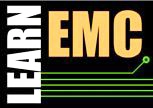EMC Question of the Week: April 28, 2025

Conduction current in copper is characterized by the
- flow of electrons
- electric field perpendicular to the surface
- time-rate-of-change of the electric field
- cross product of electric and magnetic fields
Answer
The correct answer is “a.” The current in the cross-section of a good conductor is literally defined as the time-rate-of-change of the charge passing through that cross-section at that point (i.e. dQ/dt). In copper, this is due to the flow of electrons. Most high school students would get this answer correct; however, a growing number of EMC engineers seem to be confused on this point.
In a conductor like copper, the current density is equal to the material conductivity times the electric field strength, J=σE. Copper has a high conductivity, so the magnitude of the electric field in the copper is very small. The current in copper wires is NOT equal to the field strength perpendicular to the current flow, the time-rate-of-change of the electric field, or the cross product of electric and magnetic fields.
Lately, in the EMC literature, there has been a trend to emphasize the role that EM fields play in conveying power from a circuit source to a circuit load. At very high frequencies, understanding how electromagnetic fields propagate in a transmission line helps EMC and signal integrity engineers understand how certain design choices will impact the signals and noise in a circuit. Nevertheless, one shouldn't lose sight of the fact that the fields are no more or less important than the currents. And, in copper conductors, current is the flow of electrons.
If someone tells you that EM waves in a transmission line propagate much faster than the velocity of an electron in copper, remind them that pressure waves in a water pipe travel much faster than any of the water molecules. Acoustic waves in air travel much faster than the air molecules. When waves propagate in any medium, they do not carry the medium with them.
To use the water pipe analogy, lets replace source in the transmission line figure shown above with a water pump and the load with a water fountain. We'll replace the transmission line conductors with a pair of water pipes that are full of water. Water would start flowing through the fountain almost as soon as the pump was turned on. It wouldn't have to wait for water to come all the way from the pump, because the water pipes were already full of water. Copper wires are already full of electrons. We don't need to wait for electrons to travel the length of the transmission line before the changes in the source voltage are observed at the load. Voltage and current wave propagation occurs at the speed of light in the dielectric.
Have a comment or question regarding this solution? We'd like to hear from you. Email us at
